The Belvedere is a magnificent palace complex in Vienna. Two Baroque palaces face each other on a sloping hill. Between the palaces lies a formal French garden with fountains, statues and cascades.
History
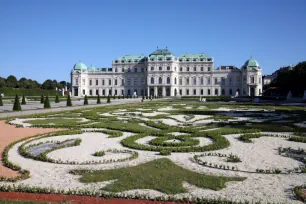
The complex was built as the summer palace for Prince Eugène of Savoy, a successful military commander of French descent who succeeded in defeating the Turkish army in 1683. The Belvedere was designed by court architect Johann Lukas von Hildebrandt, who created a masterpiece of Baroque architecture.
After the death of the childless prince in 1736, his possessions, including works of art and a large library, were sold off by his cousin Anna Victoria. In 1752, she also sold the palaces to empress Maria Theresia, who decided to use the Belvedere to house the royal art collection. In 1779, she opened the palace and gardens to the public. At the end of the nineteenth century, the art collection moved to the purpose-built Kunsthistorisches Museum.
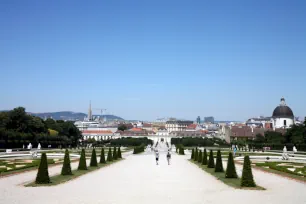
The lower palace was converted into a museum for modern art, while the upper palace became the residence of archduke Franz Ferdinand until he was assassinated in 1914, an event that led to the start of the First World War.
In 1918, after the war, the palace was appropriated by the state, after which both palaces became home to state museums. The foundation of the collections of the museums were laid by Prince Eugène of Savoy himself, who was an avid patron of the Arts and amassed a large collection of paintings and sculptures from across Europe.
Unteres Belvedere
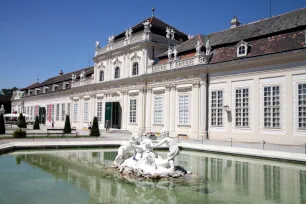
The living quarters of the Prince of Savoy were in the Unteres Belvedere or lower Belvedere. The palace was built from 1714 to 1716 and contains some magnificent rooms (Prunksaale) which are well-preserved.
Many of the rooms are open to visitors to the Barockmuseum, which has a collection of Baroque paintings and sculpture. You can visit rooms such as the Dining Room, the Mirror Hall and the Bedroom. A highlight is the Marmorsaal or Marble Hall, which is magnificently decorated with stucco reliefs and statues. The ceiling fresco, painted by Martino Altomonte in 1716, shows Prince Eugène as Apollo. Another interesting room is the Groteskensaal (Hall of Grotesques), decorated with wall murals of grotesques, painted by the German artist Jonas Drentwett in a style similar to those found in ancient Roman houses. Also interesting in this room are the bizarrely sculpted heads with extreme facial expressions. Not to be missed is the Golden Cabinet, a small but richly decorated room.
The adjoining Orangery, originally built to provide cover for plants during the winter, is now used for temporary expositions. The nearby stables are home to the Schatzhaus Mittelalter, a museum of medieval art with a large collection of paintings and sculptures from the twelfth through the early sixteenth century.
Oberes Belvedere
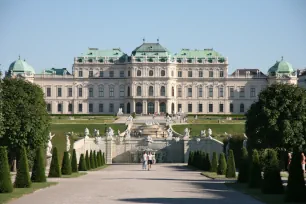
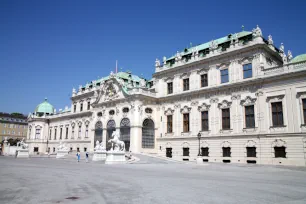
At the southern end of the park, at the top of the slope, lies the Oberes Belvedere or upper Belvedere. This palace, considered the greatest masterpiece of architect Johann Lukas von Hildebrandt, had a purely representative function and contained reception halls and banquet halls. Its exterior is much more impressive than the rather modest Unteres Belvedere. Especially the main facade, facing south, is magnificent. The many sculptures that adorn the facade are a reference to the victory over the Turkish army. The rooftop structures are said to evoke tents at Turkish army camps.
The interior of the Oberes Belvedere was designed by Claude le Fort du Plessy. Unfortunately, little of the original interior has been preserved, since the building had been actively used until the mid-twentieth century. The most impressive hall is the Sala Terrena, where large statues support the vaulted ceiling.
The palace houses the Sammlung Österreichischer Kunst, one of the top museums in Vienna. Its collection is mostly focused on artwork from the nineteenth and twentieth centuries, with works from notable artists such as van Gogh, Monet, Renoir, Schiele and Kokoschka. But the museum is best known for its unrivaled collection of works from Gustav Klimt, a famous Austrian painter who was one of the leaders of the Viennese Secession movement.
The Palace Garden
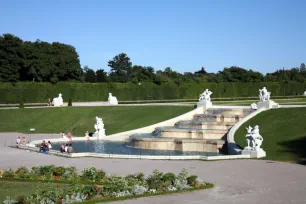
Between the Unteres Belvedere and the Oberes Belvedere lies the Belvedere garden. It was laid out between 1700 and 1725 by Dominique Girard in the formal French style. The garden is decorated with numerous statues as well as fountains and cascades. The view from the top of the sloping garden towards the Unteres Belvedere is magnificent and explains its name – Belvedere – which is Italian for beautiful view.
The garden has three levels, separated by two large cascades. The upper cascade consists of six basins flanked by statues. Even more statues adorn the lower cascade, a small waterfall.
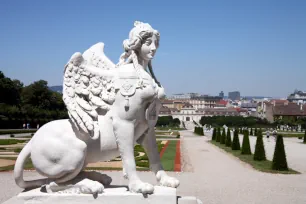
Large statues of sphinxes – symbols of strength and intelligence – decorate the upper levels of the garden. Classical statues of eight muses adorn the lower level, while statues along the staircase between the lower and middle part of the garden symbolize the twelve months of the year.
Entrance to the garden is free of charge, and it can be accessed either from the south or north side of the Belvedere complex.
- Next: Stephansdom
- More Sights & Attractions in Vienna

